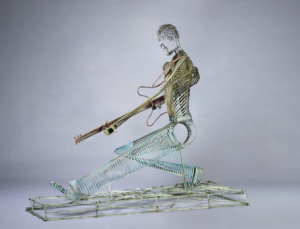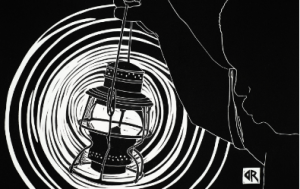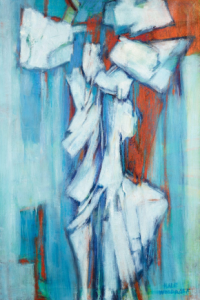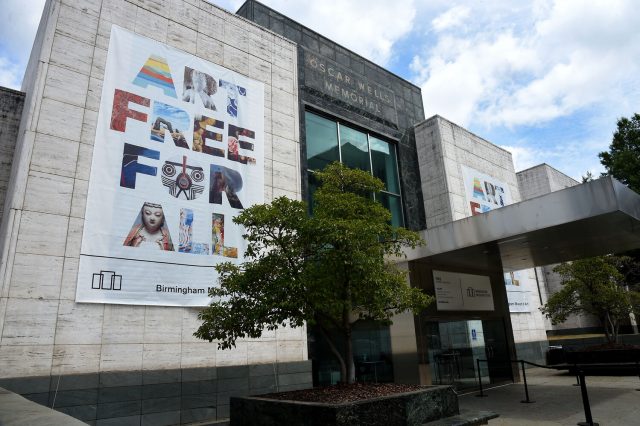The Birmingham Times
The BMA recently announced the acquisition of six major works of art advancing one of the Museum’s main collection development priorities, the American South. The artists represented in this acquisition series are:
Dawoud Bey
Debra Riffe
Howard Oubre
Hale Woodruff
Thornton Dial
Richard Dial
“These works offer greater perspectives of the American South, and enrich specific collection areas with work that carry deep connections to Alabama,” said Dr. Graham C. Boettcher, R. Hugh Daniel Director of the Birmingham Museum of Art. “Included in these acquisitions are works by both artists with whom we have enjoyed long-standing relationships, and those whose work is new to our institution.”
About the Works:

Dawoud Bey (b.1953), The Birmingham Project, 2012
The purchase of ten photographs by Dawoud Bey completes the Museum’s set of large-scale diptychs from The Birmingham Project, which originated at the BMA.
In 2012, the Birmingham Museum of Art commissioned Bey to create a series commemorating the 50th anniversary of the 16th Street Baptist Church Bombing. Through this body of work, he honors Addie Mae Collins, Carole Robertson, Cynthia Wesley, Denise McNair, Johnny Robinson, and Virgil Ware, who were all murdered in Birmingham by white supremacists on September 15, 1963.
In each diptych, Bey pairs young sitters whose ages correspond with the victims at the time of their deaths, along with a photograph of a sitter fifty years older, the same ages Collins, Robertson, Wesley, McNair, Robinson, and Ware would have been were they still alive in 2012.
Bey forces the audience to consider the enormous loss of potential that each of these children represented. The complete set of 16 photographs and a video, bolsters the Museum’s collection of art focused on the Civil Rights era and adds to a burgeoning collection of American photography.

Thornton Dial (1928 – 2016), Love Around the Jungle Cat, 1993
Born and raised in Alabama, Thornton Dial remains one of the most celebrated contemporary artists of the Deep South.
The Birmingham Museum of Art began collecting Dial’s work in 1991, however, this work represents the first of his major paintings on canvas to enter the collection.
Love Around the Jungle Cat is a monumental picture featuring recurring forms for which Dial’s work is known including lions, roosters, and women. The work builds upon the Museum’s significant collection of figurative work, by such artists as Phillip Guston, Kerry James Marshall, and Dial’s friend Lonnie Holley, among many others. Additionally, the work joins a robust collection of work by renowned Birmingham-area artists including Jack Whitten, Joe Minter, Carolyn Sherer, and Celestia Morgan. The work was generously made available to the BMA by Dial’s family.

Richard Dial, (b. 1955) Chuck Berry, 2017 and Praying Angels, undated
Richard Dial is an important contemporary designer and sculptor who lives and works in Bessemer, Alabama. Following his employment as a mechanic for the Pullman Standard Company, Dial established his own metal fabricating business in Bessemer called Dial Metal Patterns, where he made outdoor metal furniture. Dial brings together his knowledge of industrial techniques and contemporary sculpture to create fantastical chairs and benches, and other sculptural forms. Richard’s father, the famed artist Thornton Dial, also used Dial Metal Patterns as a studio, and the two artists created work there side-by-side.
The BMA purchased Dial’s life-size sculpture of the “Father of Rock and Roll,” music legend Chuck Berry, known for hits such as “Maybellene” and “Johnny B. Goode.” Dial’s portrait of Berry resonates with numerous works in the Museum’s collection inspired by music including Jack Whitten’s Black Table Setting (Homage to Duke Ellington),, Bob Thompson’s Ornette, Radcliffe Bailey’s Black and Tan, and Rico Gatson’s Untitled (Bluesologists After Gil Scott), and the Jazz Bowl designed by Viktor Schreckengost. Additionally, Dial’s bench connects with numerous sculptures and furniture in the BMA’s vast collection, including African chairs and thrones. Like Jan Jander’s Couture Benchscape, this piece blurs the line between sculpture and furniture.

Hayward Oubre, (1916 – 2006), Bongo Drummer, 1960
Standing over five-feet tall and sculpted from wire coat hangers, Hayward Oubre’s Bongo Drummer depicts a musician with his mouth open in song as he drums on a bongo held between his thighs. This dynamic work was created while Oubre was living in Alabama, teaching at Alabama State College (now Alabama State University) from 1950 to 1965, and is one of only about forty wire sculptures he created during his lifetime.
The acquisition of Oubre’s work enriches the BMA’s burgeoning collection of mid-century works made by artists working in Alabama. Before he began his MFA at the University of Iowa, Oubre studied at Atlanta University for 18 months with Nancy Prophet and Hale Woodruff. The work of friends and colleagues of Oubre’s are also held by the BMA, including the work of Sam Gilliam and Elizabeth Catlett.

Debra Riffe, (b. 1952) “walk, in the direction you goin’ in”, 2008
Debra Riffe is an emerging Birmingham artist and her series “walk, in the direction you goin’ in” is her first of her work to enter the BMA’s collection. Her compositions, mostly figurative, are images of African Americans performing routine tasks in timeless, solitary reflective moments – tasks that speak of social status and identity, intimacy and a sense of place. Riffe was the recipient of the BMA’s Collectors Circle for Contemporary Art 2019 Local Artist award.
Walk, in the direction you goin’ in includes themes of labor, Black life, as well as joy and survival. The black and white block prints are inspired by Jacob Lawrence’s Migration series (1940 – 41), and depict people migrating from Mississippi to Birmingham, Alabama. Several of the works from the series are currently on view in the BMA’s exhibition, Light Play, an exhibition of contemporary art in which artists examine the many meanings of ‘light’ and ‘play’ through medium, expression, meaning, and form.

Hale Woodruff, (1900 -1980), Torso, about 1970
This painting by Hale Woodruff–the first to enter the BMA’s collection–shows the artist working at the bounds of figuration, as he often did later in his career. He explored an abstracted reality through many subjects he painted repeatedly, including landscapes, playgrounds, African art, and the human torso, which he represents in this canvas.
The dynamic figure twists to fit into the constraints of the picture plane, and its human form is just legible within Woodruff’s geometries. The figure is surrounded by vertical swaths of blue, red, and white paint.
Woodruff was a socially motivated and culturally conscious artist throughout his career, and this was only amplified by the Civil Rights Movement. Together with Charles Alston, Romare Bearden, and Norman Lewis, Woodruff founded the artist collective Spiral, the focus of a BMA exhibition titled Spiral: Perspectives on an African-American Art Collective for the BMA (2010 – 2011). This painting not only relates to the work of Spiral artists in the collection including pieces by Alston, Bearden, and Lewis, as well as Emma Amos and Richard Mayhew, but also connects to our strong holdings of abstract expressionism and artwork from the Civil Rights era more broadly.
Location: 2000 Rev. Abraham Woods, Jr. Blvd, Birmingham, AL 35203
Hours: Tuesday-Saturday, 10AM-5PM | Sunday, 12-5PM | Closed Monday
Price: General Admission is free
Website | Facebook | Instagram
Still looking for New Year’s plans? Get your tickets and head to the Birmingham Museum of Art for an unforgettable New Year’s Eve affair.
Founded in 1951, the Birmingham Museum of Art, one of the finest regional museums in the United States, houses a diverse collection of more than 27,000 paintings, sculpture, prints, drawings, decorative arts, and other objects dating from ancient to modern times. The Museum’s permanent collection presents a rich panorama of cultures from around the world including extensive holdings of Asian, European, American, African, African American, Pre-Columbian, and Native American art.




